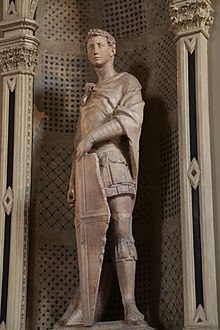
Back Sint Joris Afrikaans Georg (Heiliger) ALS ቅዱስ ጊዮርጊስ (ሰማዕት) Amharic Sant Chorche AN جرجس Arabic ܡܪܝ ܓܝܘܪܓܝܣ ܣܗܕܐ ARC مار جرجس ARZ San Xurde AST Müqəddəs Georgi Azerbaijani Švėnts Jorgis BAT-SMG
Saint George (Greek: Γεώργιος, translit. Geṓrgios;[note 1] died 23 April 303), also George of Lydda, was an early Christian martyr who is venerated as a saint in Christianity. According to tradition, he was a soldier in the Roman army. Of Cappadocian Greek origin, he became a member of the Praetorian Guard for Roman emperor Diocletian, but was sentenced to death for refusing to recant his Christian faith. He became one of the most venerated saints, heroes, and megalomartyrs in Christianity, and he has been especially venerated as a military saint since the Crusades. He is respected by Christians, Druze, as well as some Muslims as a martyr of monotheistic faith.
In hagiography, as one of the Fourteen Holy Helpers and one of the most prominent military saints, he is immortalized in the legend of Saint George and the Dragon. His feast day, Saint George's Day, is traditionally celebrated on 23 April. Historically, the countries of England, Bosnia and Herzegovina, Bulgaria, Georgia, Ukraine, Malta, Ethiopia, the regions of Catalonia and Aragon, and the city of Moscow have claimed George as their patron saint, as have several other regions, cities, universities, professions, and organizations. The Church of Saint George in Lod (Lydda), Israel, has a sarcophagus traditionally believed to contain St. George's remains.[6]
- ^ "Saint George". Encyclopædia Britannica (Online ed.). Retrieved 21 July 2022.
- ^ "St. George". Catholic Encyclopedia. Retrieved 21 July 2022.
- ^ Murphy-O'Connor, Jerome (2008). The Holy Land: An Oxford Archaeological Guide from Earliest Times to 1700. OUP Oxford. p. 205. ISBN 9780191647666.
- ^ Otto Friedrich August Meinardus, Two Thousand Years of Coptic Christianity (1999), p. 315 Archived 13 November 2022 at the Wayback Machine.
- ^ Domar: the calendrical and liturgical cycle of the Armenian Apostolic Orthodox Church, Armenian Orthodox Theological Research Institute, 2002, pp. 504–505
- ^ G. Massiot (2023). "Church of Saint George, Lod: Interior, view of the nave from the southeast end". CurateND. University of Notre Dame. doi:10.7274/24858729.v1. Retrieved 11 May 2022.
Cite error: There are <ref group=note> tags on this page, but the references will not show without a {{reflist|group=note}} template (see the help page).
